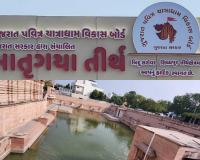Siddhpur: A Historic Pilgrimage Site for Matru Shradh Rituals

Ahmedabad, September 24: Siddhpur, a historic town located on the banks of the ancient Saraswati River in Gujarat's Patan district, is renowned across India for the Matru Shradh (rituals performed for deceased mothers). It is believed that a mother’s final wish is for her son to offer 'Pind Daan' (ritual offerings) for her at Siddhpur’s Matrugaya posthumously. Every year, during the Bheeshma Panchak festival from Ekadashi to Purnima in the Kartik month, thousands of pilgrims gather at this sacred site to perform rituals and offerings for the peace of their ancestors' souls.
Siddhpur holds immense religious and historical significance and was formerly known as 'Shreesthal.' During the reign of the illustrious Solanki king Siddhraj Jaisinh, the city was renamed Siddhpur in his honor.
According to the Gujarat Pavitra Yatradham Vikas Board, last year alone, around 47,100 families performed the Matru Shradh ritual at Siddhpur’s Bindu Sarovar, following traditional rites during the auspicious months of Kartik, Bhadrapad, and Chaitra.
The Gujarat government is continuously working to enhance the experience for pilgrims who come from all over the country to perform these sacred rites. In this effort, the Pavitra Yatradham Vikas Board is set to launch an online portal that will provide detailed information about the available facilities, connect visitors with priests, outline the rituals, and offer online registration. The portal aims to streamline the process for devotees visiting Siddhpur. To further assist, a site map has been placed at the venue, and arrangements have been made for up to 200 families to perform their rituals simultaneously.
In 2012, under the guidance of then-Chief Minister and now Prime Minister Narendra Modi, significant developments took place at Bindu Sarovar, including the construction of a new reservoir, an exhibition highlighting the importance of Matru Shradh, a museum, a seating area with canopies for rituals, a replica of Rudramahalaya, a park, bathing facilities, and a solar-powered system, among others.
Additional services, such as clean drinking water, public restrooms, dedicated halls for performing rituals, changing rooms, and proper lighting, have been introduced for the convenience of visitors. Continuous maintenance ensures cleanliness throughout the complex, with filtration pumps purifying the water of both Bindu Sarovar and Alpa Sarovar. E-rickshaws have also been made available for senior citizens.
In the near future, digital solutions will further simplify the process for devotees. An ‘Online Queue Management System’ is set to be launched, offering online registration, booking of time slots, and payment options for the Pind Daan rituals.
Bindu Sarovar: A Mythologically Significant Site
Siddhpur is also home to the Bohra Wada, a collection of historic buildings that showcase extraordinary architectural brilliance with a distinct European influence. These structures have been recognized by the United Nations and are listed as World Heritage Sites.
Bindu Sarovar, one of the four holy lakes in India, holds deep significance in Hindu mythology. It is believed that Lord Vishnu’s tears fell into this lake, giving it its name—Bindu, meaning "drop." The legend also states that Lord Parshuram, the sixth avatar of Vishnu, performed the Pind Daan for his mother, Renuka, on the banks of Bindu Sarovar. A temple dedicated to Parshuram stands near the lake, and the area is said to have been a site for penance by many sages.
During the month of Kartik, thousands of families from across India visit Siddhpur to perform the sacred Matru Shradh ritual, which is believed to bring peace to the departed souls of their mothers.



